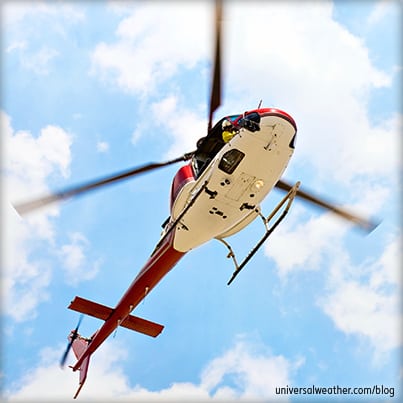Heli Flight Ops – Unique Planning


Due to short operating ranges of helicopters, operators often face limitations when planning international or long-range movements. Certain countries are more complex and stringent than others in terms of requirements, restrictions, and permits. In some situations, depending upon route of flight and permits required, the most practical option may be to ship the helicopter to a certain location rather than attempt to fly direct. It’s important to begin communicating early with your 3rd-party provider to determine how best to orchestrate an international heli flight.
1. What challenges should operators consider when planning heli trips?
Fuel availability is a key consideration depending upon the type of fuel you use, range of aircraft, and remoteness of operation. It may be difficult finding specific types of fuel at smaller or remote airfields, and in certain cases, fuel will have to be repositioned to a location. Customs availability can be another challenge, as airports of entry (AOEs) are not always accessible along your route of flight. In some cases, but not always, customs will come out to your landing location at an additional cost. You’ll also need to determine if permits are required for overflight or landing. As helicopters typically operate under visual flight rules (VFR) at low altitudes, permits may or may not be required. Keep in mind, also, that support and ground handling services may be very limited or non-existent at remote locations.
2. What regions of the world require more planning time?
The Middle East, northern Africa, and China typically require additional pre-planning. In some cases, planned schedules will need to be revised completely, as certain destinations may not permit, or may severely limit, heli ops. China, for example, is highly restrictive on approvals of heli ops, and you may need to divert around the country unless you have local business contacts to assist with the permit process. You’ll have additional pre-planning considerations in regions with sizeable distances between airports/heliports. Your helicopter may not have the range to make it to the next practical location with fuel and customs availability.
3. How do heli permits differ from fixed-wing business aircraft permits?
Due to the nature of heli ops – low flight levels often operating VFR direct via GPS – it’s often difficult to provide authorities with crossing points and times normally required to confirm operating permits. Civil aviation authorities (CAAs) may be unfamiliar with heli ops. They prefer to have full and detailed operating schedules and proposed routes as opposed to random GPS routes.
4. Are weather issues key considerations?
When winds and weather conditions are adverse, a heli crew may be grounded for days en route. This can complicate the permit process and create challenges in terms of permit revisions. It’s best to try to obtain a blanket permit, due to the possibility of bad weather, but this option is not always possible.
5. What documentation is required for permits?
Basic documentation for heli permits includes airworthiness, registration, worldwide insurance, and noise certificates. When operating in certain regions, such as the Middle East, CAAs often want pilot licenses and medical certificates along with a local business contact. If you do not have a local business contact, you’ll need to specify your reasons for entering the country. Permits for helicopters on experimental certificates are more complex and require at least five working days’ lead time.
6. Are random route ops more challenging?
It’s usually best to follow specific routes, especially when crossing Flight Information Region (FIR) boundaries. If you plan to fly random routes, you’ll need to communicate with CAA and explain reasons for your routings. Permits for ops to non-airfield lat/long coordinates, such as to a ship or yacht at sea, are often challenging and require additional lead time.
7. What sort of airport restrictions might we face?
The main airport operating restrictions you’ll encounter are noise restrictions, and these are usually more restrictive at night. Many airport authorities require noise certificates for heli ops and will often restrict operations to daylight hours. Ensure that you’re arriving or departing during the allowed periods. Depending on the airport/heliport, services on the ground may be limited, and hangar accommodation may not be available. In such cases, it’s best to proceed to an airport with adequate services for overnight stops.
8. May we land at an airport that’s not an AOE?
In some cases, you will not have the range to make it to an AOE for first landing in a country. Some CAAs may provide approval, due to limited range, to land at a domestic airport prior to proceeding to an AOE for customs clearance. If this option is permitted, consider carrying reserve canisters of fuel so that you may not need to refuel at the intermediate airport. In some cases, customs officers may come out to clear you at a non-AOE, but this is not guaranteed. As a last resort, you can always consider shipping the helicopter to the destination.
9. What services can 3rd-party providers offer?
3rd-party providers can assist in communicating with local CAAs to gain clarity on requirements and restrictions in regards to heli routings and permits. They’ll assist with planning and route determination, even in cases where it’s just VFR routings. Provide your 3rd-party provider with range of your helicopter, maximum flight level, cruise speed, and useful payload weight information, so that tankering of fuel, when advantageous, may be considered.
Conclusion
When planning a long-distance or international heli flight, it’s important to plan ahead. Be prepared for changes to your proposed routing and schedule based on permit, customs, and fuel availability issues. Workable solutions are available for most planned operations, but there will be times, usually due to permit issues, when you may need to consider shipping the helicopter to the destination or to a point along the route to your planned destination.
Questions?
If you have any questions about this article, contact Louis Smyth at louissmyth@univ-wea.com.



